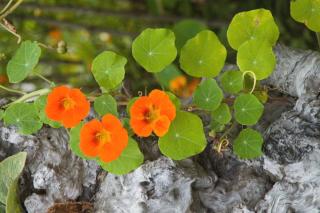

Nasturtium is a climbing vine famous both for its blooms and for the speed with which it develops.
Main facts about Nasturtium
Name – Tropaeolum
Family – Tropaeolaceae
Type – climbing vine
Height – 10 to 20 feet (3 to 6 meters)
Exposure – full sun
Soil: ordinary – Foliage: deciduous – Flowering: end of spring → mid-fall
Caring for it is easy and it is guaranteed to produce a great decorative impact!

Here is how to sow nasturtium from seed:
It doesn’t need any pruning. If you let the plants self-seed and you’re aiming to cover a wall or arbor, thin the sprouts so that at most a dozen remain. That way, you’ll ensure they’re vigorous enough to climb higher.
As for care, you might need to water a bit if it doesn’t rain for a long time. The vine will bounce back in no time, though, so even if you don’t water it’ll survive.
In fall, when temperatures start dropping, the entire vine starts yellowing. Seeds fall everywhere and will hibernate until the next spring.
At times, you’ll notice caterpillars. These usually come from a white butterfly named Pieris brassicae.
Beautiful climbers, nasturtiums can also be grown in pots like flowing plants. Aphids love this flower, so make the best of it by using it as a decoy to protect nearby flowers.
They are easy to care for and grow and need very little fertilizer. Too much fertilizer would actually reduce blooming.
An interesting fact is that Nasturtium is edible: leaves, seeds. For some species even roots are edible, as in mashua.
To hinder the spread of aphids on this vine, plant lavender nearby for its aphid-repellent properties.
Thanks so much for your information.
You’re very welcome!